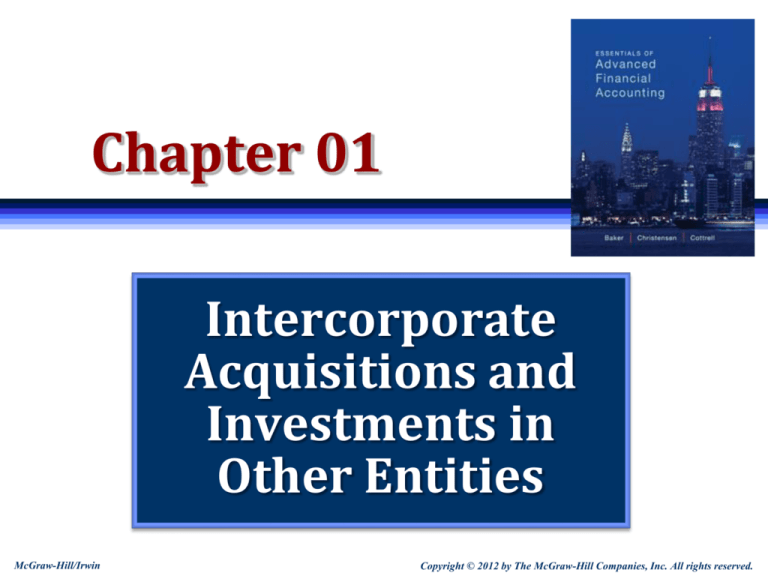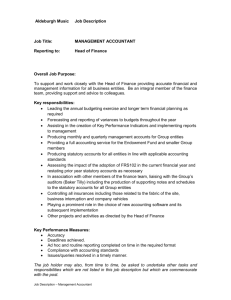
Chapter 01
Intercorporate
Acquisitions and
Investments in
Other Entities
McGraw-Hill/Irwin
Copyright © 2012 by The McGraw-Hill Companies, Inc. All rights reserved.
Learning Objective 1
Understand and explain
different methods of
business expansion, types of
organizational structures,
and types of acquisitions.
1-2
Business Expansion
Most business enterprise seek to expand over time
Why ? and How ?
Why ?
Size often allows economies of scale
New earning potential
Earnings stability through diversification
Management rewards for bigger company size
Prestige associated with company size
1-3
Business Expansion
Most business enterprise seek to expand over time
Why ? and How ?
How?
By one of two Approaches
Internal expansion
Expansion of its existing product line
New product development
External expansion
By combining with or Acquiring other companies
Either approach may lead to a change
in organizational structure
1-4
Business Expansion
And organization Structure.
Internal Expansion
Through new subsidiary, or other entity
such as :
Partnership,
joint venture
special entities
P
Internal
Expansion
( Note : assets transferred to the new)
Stock
$
S
1-5
Business Expansion
And organization Structure.
A spin-off
Occurs when the ownership of a newly created or
existing subsidiary is distributed to the parent’s
stockholders without the stockholders
surrendering any of their stock in the parent
company
A split-off
Occurs when the subsidiary’s shares are
exchanged for shares of the parent, thereby
leading to a reduction in the outstanding shares of
the parent company
1-6
Business Expansion
And organization Structure.
External Expansion
Entry into new product areas or geographic
regions by acquiring or combining with
other companies.
$
External
Expansion
P
Stock
Sub
Shareholders
S
1-7
Business Expansion
And organization Structure.
External Expansion
A business combination occurs when “. . .
an acquirer obtains control of one or more
businesses.”
The concept of control relates to the ability
to direct policies and management.
1-8
Organizational Structure and Reporting
Merger
A business combination in which the acquired
company’s assets and liabilities are combined
with those of the acquiring company results in no
additional organizational components.
Financial reporting is based on the original
organizational structure.
1-9
Organizational Structure and Reporting
Controlling ownership
A business combination in which the acquired
company remains as a separate legal entity with a
majority of its common stock owned by the
purchasing company leads to a parent–subsidiary
relationship.
Accounting standards normally require
consolidated financial statements.
1-10
Organizational Structure and Reporting
Noncontrolling ownership
The purchase of a less-than-majority interest in another
corporation does not usually result in a business
combination or controlling situation.
Other beneficial interest
One company may have a beneficial interest in another
entity even without a direct ownership interest.
The beneficial interest may be defined by the agreement
establishing the entity or by an operating or financing
agreement.
1-11
1-12
Learning Objective 2
Make calculations and
prepare journal entries for
the creation and purchase of
a business entity.
1-13
Creating Business Entities
1-14
Creating Business Entities
1-15
Creating Business Entities
1-16
1-17
Creating Business Entities
Recognition of fair values of the assets
transferred in excess of their carrying values
on the books of the transferring company is
not appropriate in the absence of an arm’slength transaction.
No gains or losses are recognized on the
transfer by the transferring company.
1-18
Creating Business Entities
If the value of an asset transferred to a newly
created entity has been impaired prior to the
transfer and its fair value is less than the
carrying value on the transferring company’s
books, the transferring company should
recognize an impairment loss and transfer the
asset to the new entity at the lower fair value.
1-19
Learning Objective 3
Understand and explain
the differences between
different forms of
business
combinations.
1-20
Forms of Business Combinations
A statutory merger
The acquired company’s assets and liabilities are
transferred to the acquiring company, and the acquired
company is dissolved, or liquidated
The operations of the previously separate companies are
carried on in a single legal entity
A statutory consolidation
Both combining companies are dissolved and the assets
and liabilities of both companies are transferred to a
newly created corporation
1-21
Forms of Business Combinations
A stock acquisition
One company acquires the voting shares of another
company and the two companies continue to operate as
separate, but related, legal entities.
The acquiring company accounts for its ownership
interest in the other company as an investment.
Parent–subsidiary relationship
For general-purpose financial reporting, a parent company
and its subsidiaries present consolidated financial
statements that appear largely as if the companies had
actually merged into one.
1-22
Forms of Business Combinations
AA Company
AA Company
BB Company
(a) Statutory Merger
AA Company
CC Company
BB Company
(b) Statutory Consolidation
AA Company
AA Company
BB Company
BB Company
(c) Stock Acquisition
1-23
Determining the Type of Business Combination
AA Company invests in BB Company
Acquires net
assets
Peaceful
Merger
Acquires stock
Yes
Hostile
Takeover
Record as statutory
merger or statutory
consolidation
Acquired company
liquidated?
No
Record as stock
acquisition and
operate as subsidiary
1-24
Learning Objective 4
Make calculations and
prepare journal entries for
different types of business
combinations through the
acquisition of stock or
assets.
1-25
Accounting for Business Combination
1-26
Accounting for Business Combination
1-27
Accounting for Business Combination
1-28
Accounting for Business Combination
1-29
Accounting for Business Combination
1-30
Accounting for Business Combination
1-31
Accounting for Business Combination
1-32







